Evaluating the Field Performance of Permeable Concrete Pavers
Abstract
:1. Introduction
- (a)
- Infiltration rates through PICPs are variable, even for different test occasions at the same location.
- (b)
- During storm events and extended tests, infiltration rates decline with time, as systems become saturated.
- (c)
- Rates are very high for laboratory tests and new field installations, but decline with age in the field, with the main cause being blockage by fine sediments.
- (d)
- There can be difficulties in reversing this process through maintenance and renewal operations.
2. Materials and Methods
2.1. Locations of Field Tests
2.2. SRIT (Single Ring Infiltrometer Test)
2.3. SWIFT (Stormwater Infiltration Field Test)
3. Results
3.1. Field Tests: SRIT and SWIFT Comparison
3.2. Discussion on Variability
3.3. Analysis of Factors Influencing the Infiltration Rate
3.4. Prediction Limits
4. Conclusions
Supplementary Materials
Author Contributions
Funding
Data Availability Statement
Acknowledgments
Conflicts of Interest
References
- Pratt, C.; Mantle, J.; Schofield, P. UK Research Into the Performance of Permeable Pavement, Reservoir Structures in Controlling Stormwater Discharge Quantity and Quality. Water Sci. Technol. 1995, 32, 63–69. [Google Scholar] [CrossRef]
- Eisenberg, B.; Lindow, K.; Smith, D. (Eds.) Permeable Pavements, Permeable Pavements Task Committee; American Society of Civil Engineers: Reston, VA, USA, 2015.
- Pearson, A.R.; Shackel, B. Concrete segmental pavements aesthetic and performance solutions. In Proceedings of the 5th International Conference on Concrete Block Paving, Tel-Aviv, Israel, 23–27 June 1996; pp. 669–678. [Google Scholar]
- Bean, E.Z.; Hunt, W.F.; Bidelspach, D.A.; Smith, J.E. Evaluation of Four Permeable Pavement Sites in Eastern North Carolina for Runoff Reduction and Water Quality Impacts. J. Irrig. Drain. Eng. 2007, 133, 583–592. [Google Scholar] [CrossRef]
- Winston, R.; Al-Rubaei, A.; Blecken, G.; Hunt, W. A Simple Infiltration Test for Determination of Permeable Pavement Maintenance Needs. J. Environ. Eng. 2016, 142, 06016005. [Google Scholar] [CrossRef]
- Collins, K.A.; Hunt, W.F.; Hathaway, J.M. Hydrologic Comparison of Four Types of Permeable Pavement and Standard Asphalt in Eastern North Carolina. J. Hydrol. Eng. 2008, 13, 1146–1157. [Google Scholar] [CrossRef]
- Drake, J.; Bradford, A.; Marsalek, J. Review of environmental performance of permeable pavement systems: State of the knowledge. Water Qual. Res. J. 2013, 48, 203–222. [Google Scholar] [CrossRef]
- Valeo, C.; Gupta, R. Determining Surface Infiltration Rate of Permeable Pavements with Digital Imaging. Water 2018, 10, 133. [Google Scholar] [CrossRef] [Green Version]
- Dierkes, C.; Kuhlmann, J.; Kandasamy, J.; Angelis, G. Pollution Retention Capability and Maintenance of Permeable Pavements. In Proceedings of the 7th International Conference on Urban Drainage, Portland, OR, USA, 8–13 September 2002. [Google Scholar]
- Boogaard, F.; Lucke, T.; van de Giesen, N.; van de Ven, F. Evaluating the Infiltration Performance of Eight Dutch Permeable Pavements Using a New Full-scale Infiltration Testing Method. Water 2014, 6, 2070–2083. [Google Scholar] [CrossRef]
- Borgwardt, S. Long Term In-Situ Infiltration Performance of Permeable Concrete Block Pavement. In Proceedings of the 8th International Conference on Concrete Block Paving, San Francisco, CA, USA, 8–11 September 2015. [Google Scholar]
- Cipolla, S.; Maglionico, M.; Stojkov, I. Experimental Infiltration Tests on Existing Permeable Pavement Surfaces. CLEAN—Soil Air Water 2015, 44, 89–95. [Google Scholar] [CrossRef]
- Sañudo-Fontaneda, L.; Andres-Valeri, V.; Costales-Campa, C.; Cabezon-Jimenez, I.; Cadenas-Fernandez, F. The Long-Term Hydrological Performance of Permeable Pavement Systems in Northern Spain: An Approach to the “End-of-Life” Concept. Water 2018, 10, 497. [Google Scholar] [CrossRef] [Green Version]
- Lucke, T.; White, R.; Nichols, P.; Borgwardt, S. A Simple Field Test to Evaluate the Maintenance Requirements of Permeable Interlocking Concrete Pavements. Water 2015, 7, 2542–2554. [Google Scholar] [CrossRef] [Green Version]
- Beecham, S.; Pezzaniti, D.; Myers, B.; Shackel, B.; Pearson, A. Experience In The Application of Permeable Interlocking Concrete Paving in Australia. In Proceedings of the 9th International Conference on Concrete Block Paving, Buenos Aires, Argentina, Argentinean Concrete Block Association (AAHB), Buenos Aires, Argentina, 18–21 October 2009; Argentinean Portland Cement Institute (ICPA) Small Element Paving Technologists (SEPT): Buenos Aires, Argentina. [Google Scholar]
- Shackel, B. The Design, Construction and Evaluation of Permeable Pavements in Australia. In Proceedings of the 24th ARRB Conference: Celebrating 50 years of Road and Transport Research 2010, Melbourne, VIC, Australia, 12–15 October 2010. [Google Scholar]
- Boogaard, F.; Lucke, T. Long-Term Infiltration Performance Evaluation of Dutch Permeable Pavements Using the Full-Scale Infiltration Method. Water 2019, 11, 320. [Google Scholar] [CrossRef] [Green Version]
- Johnson, T.; King, R. Experience with Pervious Paving. In Proceedings of the 6th Australian National Conference on Urban Water Management: New Frontiers into the Next Decade, Virtually, 13–16 April 2021. [Google Scholar]
- Ku-ring-gai Council. Current Projects and Priorities, Water Smart Rebates. 2018. Available online: https://www.kmc.nsw.gov.au/Current_projects_priorities/Key_priorities/Environment_sustainability/Our_community_programs/Water_Smart/Water_Smart_rebates (accessed on 20 May 2019).
- Moktan, B. Understanding the Design and Approval Process of Permeable Pavements in Australia, Engineering Graduate Project; University of Technology: Sydney, Australia, 2018; pp. 6–10. [Google Scholar]
- C1781/C1781M-14a; Standard Test Method for Surface Infiltration Rate of Permeable Unit Pavement Systems. ASTM International: West Conshohocken, PA, USA, 2014.
- HydroSTON 2016, Designs and Specification, Sydney. Available online: https://hydroston.com.au/specifications/ (accessed on 4 April 2019).
- Adbri Masonry. Types of Pavers: Ecotrihex, Sydney. 2019. Available online: https://www.adbrimasonry.com.au/commercials/paving/industrial-paving/ecotrihex-2 (accessed on 4 April 2019).
- Current Results. Sydney-Extreme Daily Rainfall for Each Year. Current Results Weather and Science Facts (2022). Available online: https://www.currentresults.com/Yearly-Weather/Australia/NSW/Sydney/extreme-annual-sydney-precipitation.php (accessed on 8 June 2022).
- Brown, C.; Chu, A.; van Duin, B.; Valeo, C. Characteristics of Sediment Removal in Two Types of Permeable Pavement. Water Qual. Res. J. 2009, 44, 59–70. [Google Scholar] [CrossRef] [Green Version]
- NSW Department of Planning and Environment. Apartment Design Guide; NSW Department of Planning and Environment: Sydney, Australia, 2015; ISBN 978-0-7313-3676-0.
- NSW Department of Planning and Environment. New England North West Regional Plan, Sydney, Australia. 2018. Available online: https://www.planning.nsw.gov.au/Plans-for-your-area/Regional-Plans/New-England-North-West/Draft-New-England-North-West-Regional-Plan/Protected-water-environment-and-heritage?acc_section=direction_5_1_-_manage_water_resources_for_a_growing_economy_and_environmental_sustainability (accessed on 28 August 2018).
- City of Botany Bay. Development Control Plan 2013, Stormwater Management Technical Guidelines, Sydney, Australia. Available online: https://www.bayside.nsw.gov.au/sites/default/files/2018-01/Part-10-Stormwater-Mgmt-Tech-Guidelines_Amd8_A09081_E050917.pdf (accessed on 3 June 2019).
- Blacktown City Council, Water Sensitive Urban Design (WSUD) Standard Drawings, Plan & Build, Stage 2—Plans and Guidelines, Developers Toolkits for Water Sensitive Urban Design (WSUD). 2017. Available online: https://www.blacktown.nsw.gov.au/Plan-build/Stage-2-plans-and-guidelines/Developers-toolkit-for-water-sensitive-urban-design-WSUD/Water-sensitive-urban-design-WSUD-standard-drawings (accessed on 3 November 2019).
- Razzaghmanesh, M.; Beecham, S. A Review of Permeable Pavement Clogging Investigations and Recommended Maintenance Regimes. Water 2018, 10, 337. [Google Scholar] [CrossRef] [Green Version]
- Concrete and Masonry Association of Australia. Permeable Interlocking Concrete Pavements—Design and Construction Guide; Concrete and Masonry Association of Australia: Sydney, Australia, 2010. [Google Scholar]
- NSW Roads & Maritime Services. Test Method T377, Water Permeability of no Fines Concrete (Falling Head Laboratory Permeameter); RMS NSW Government: Sydney, Australia, 2016.
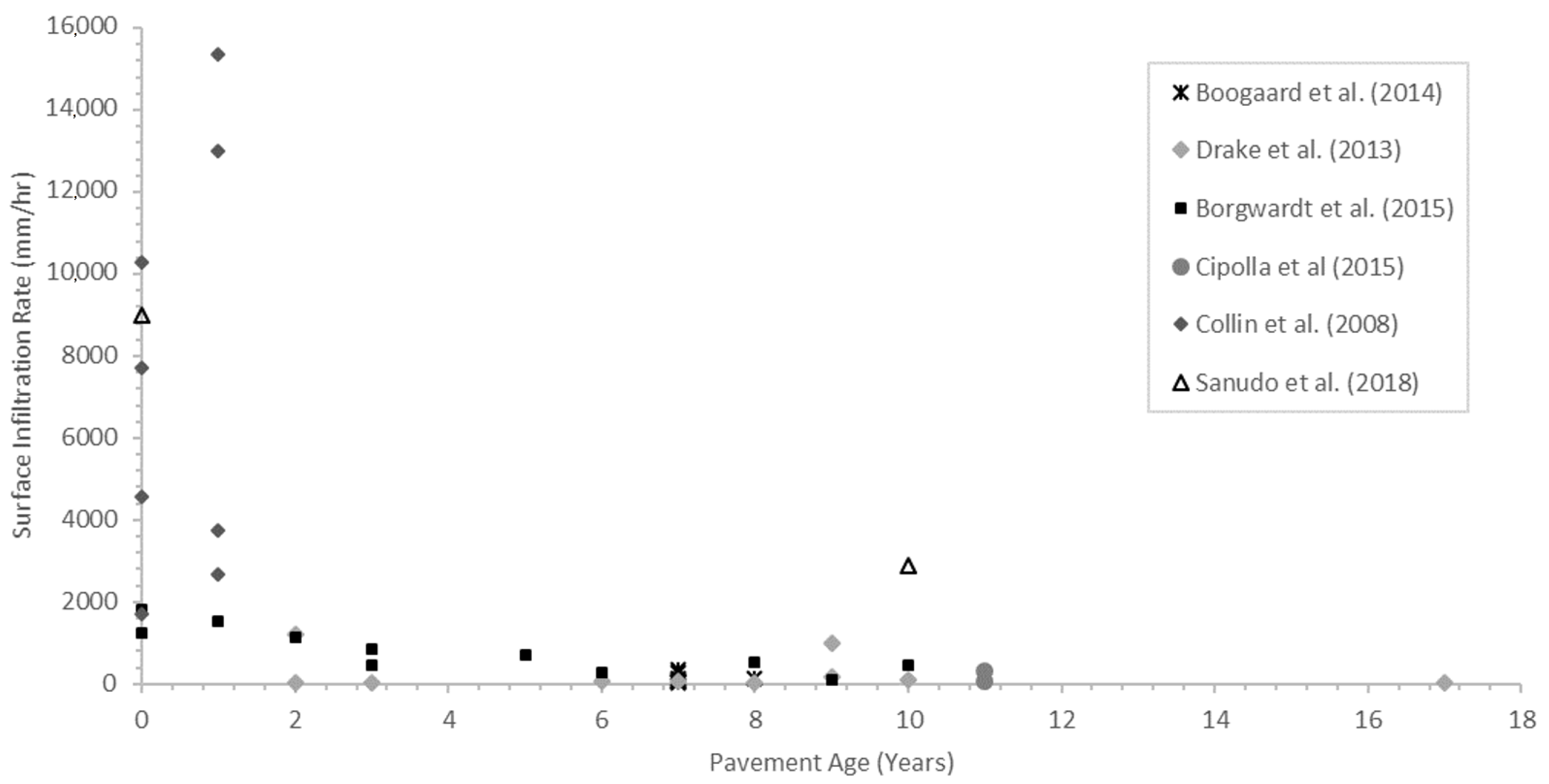
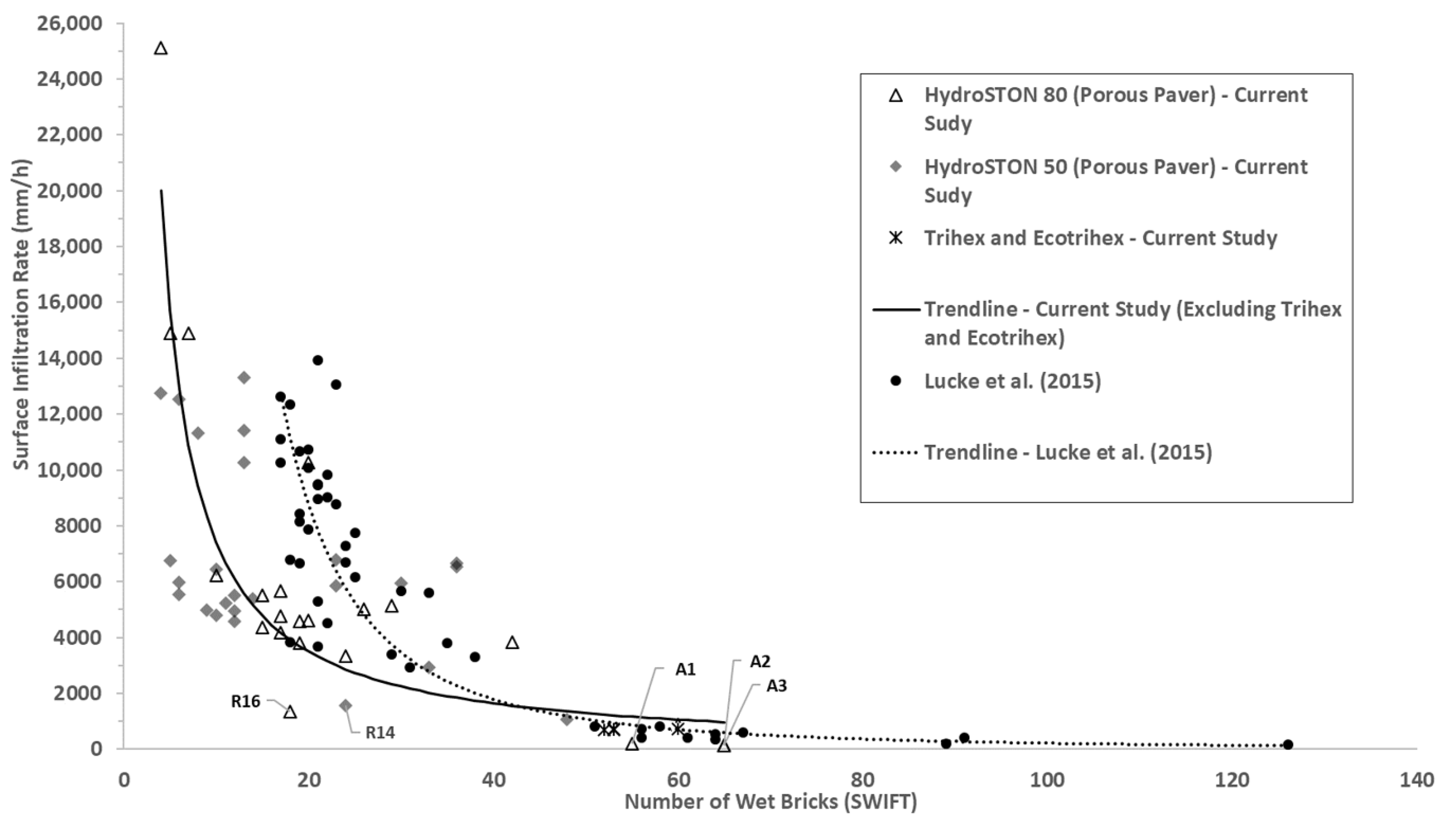
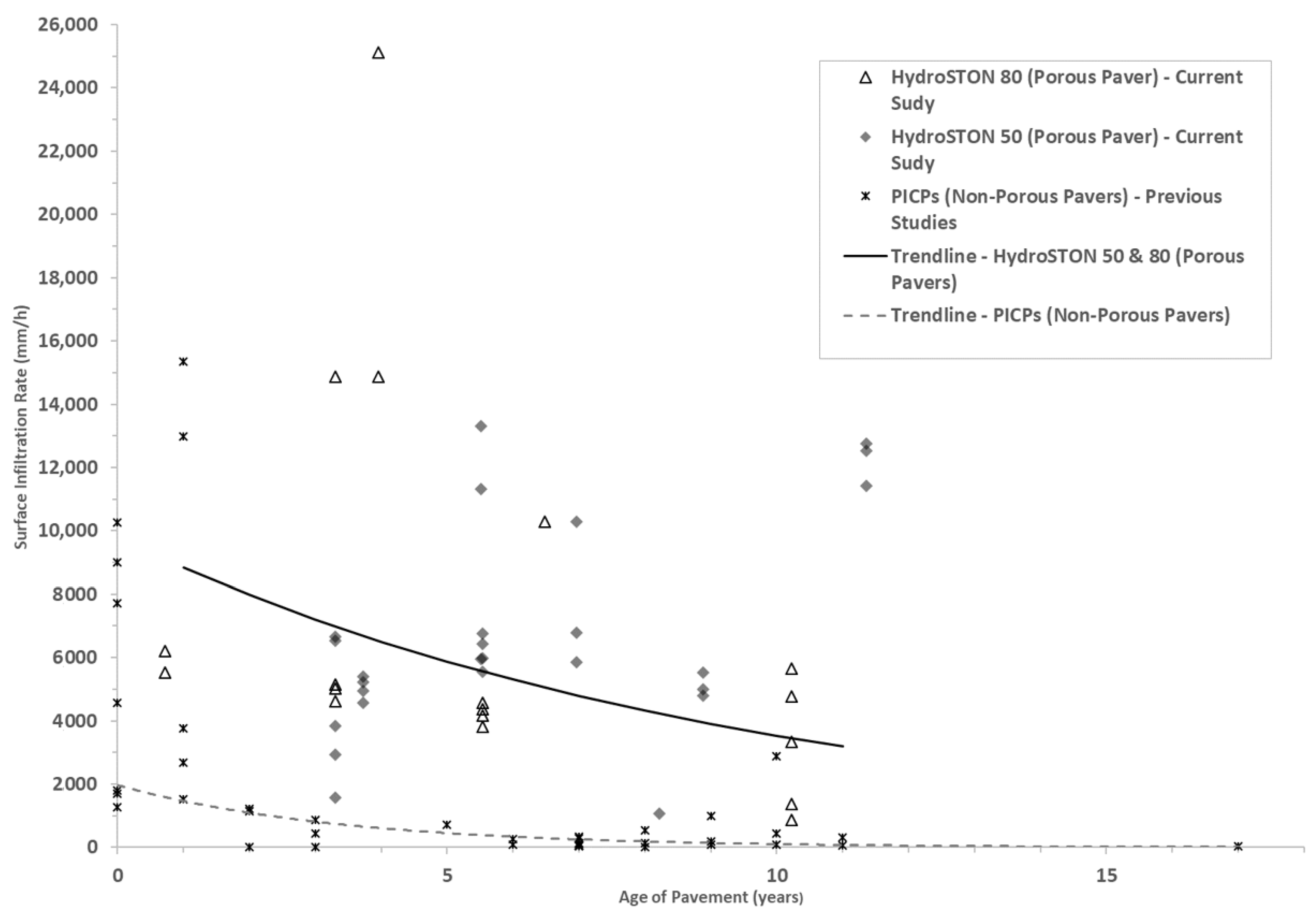
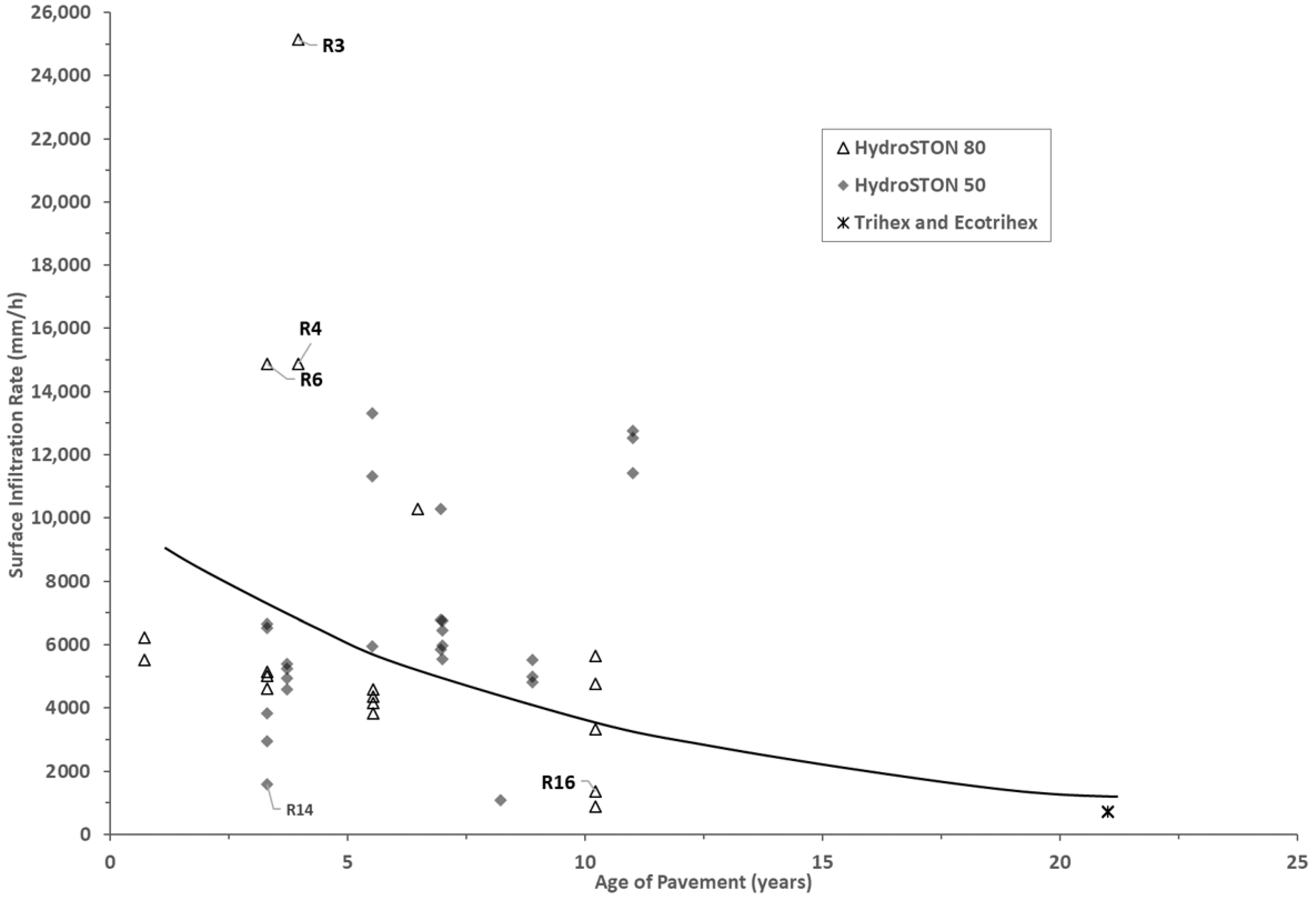
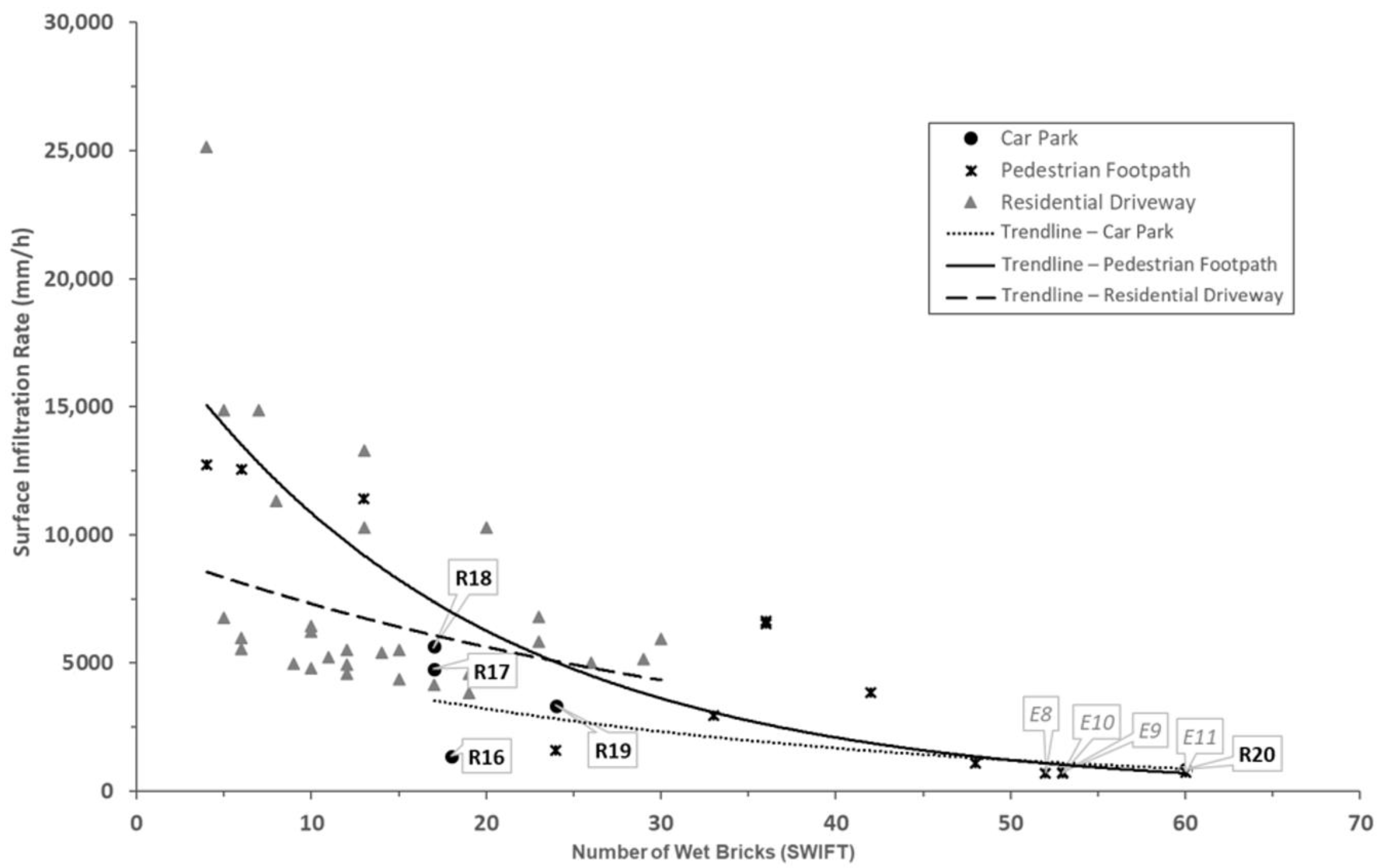

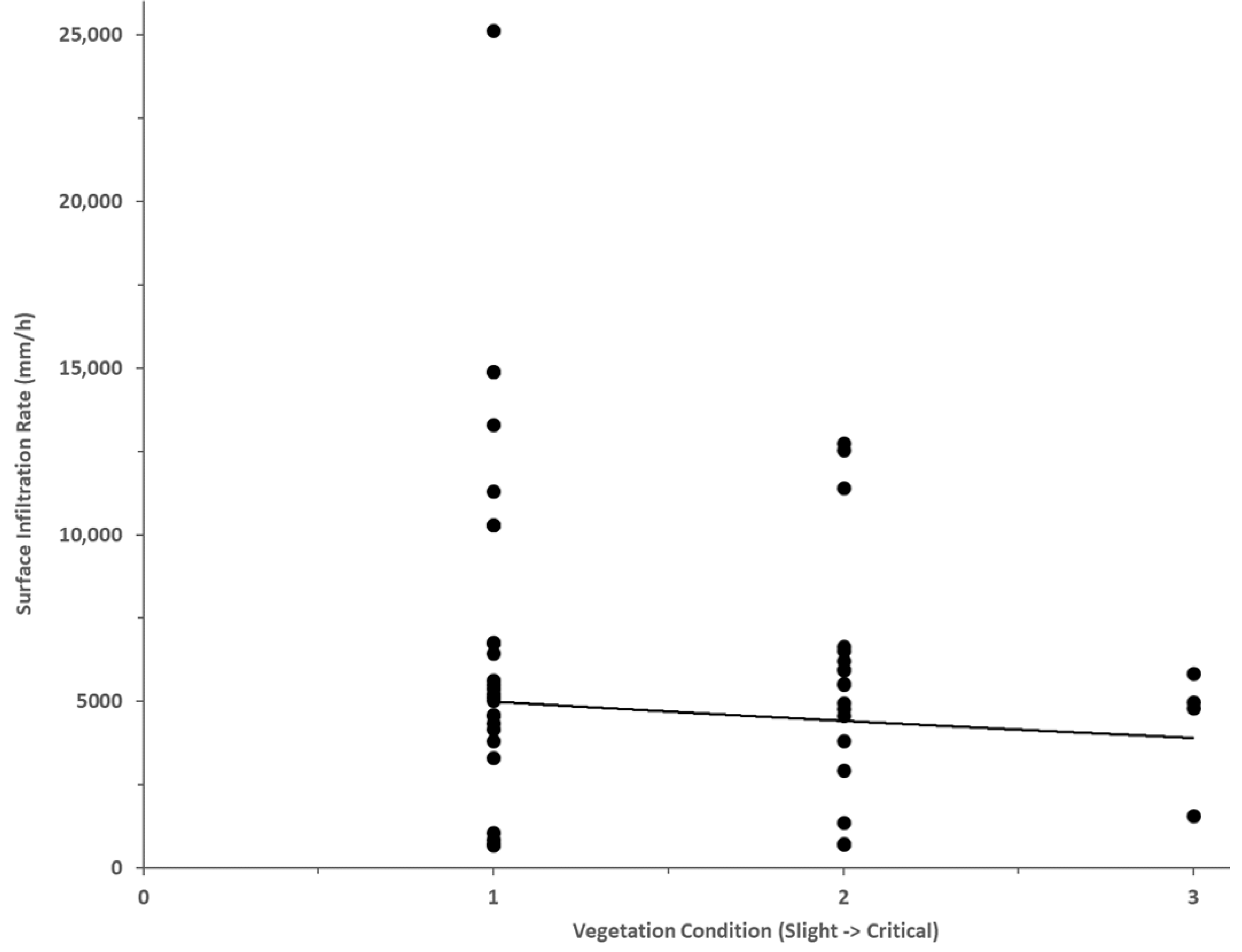

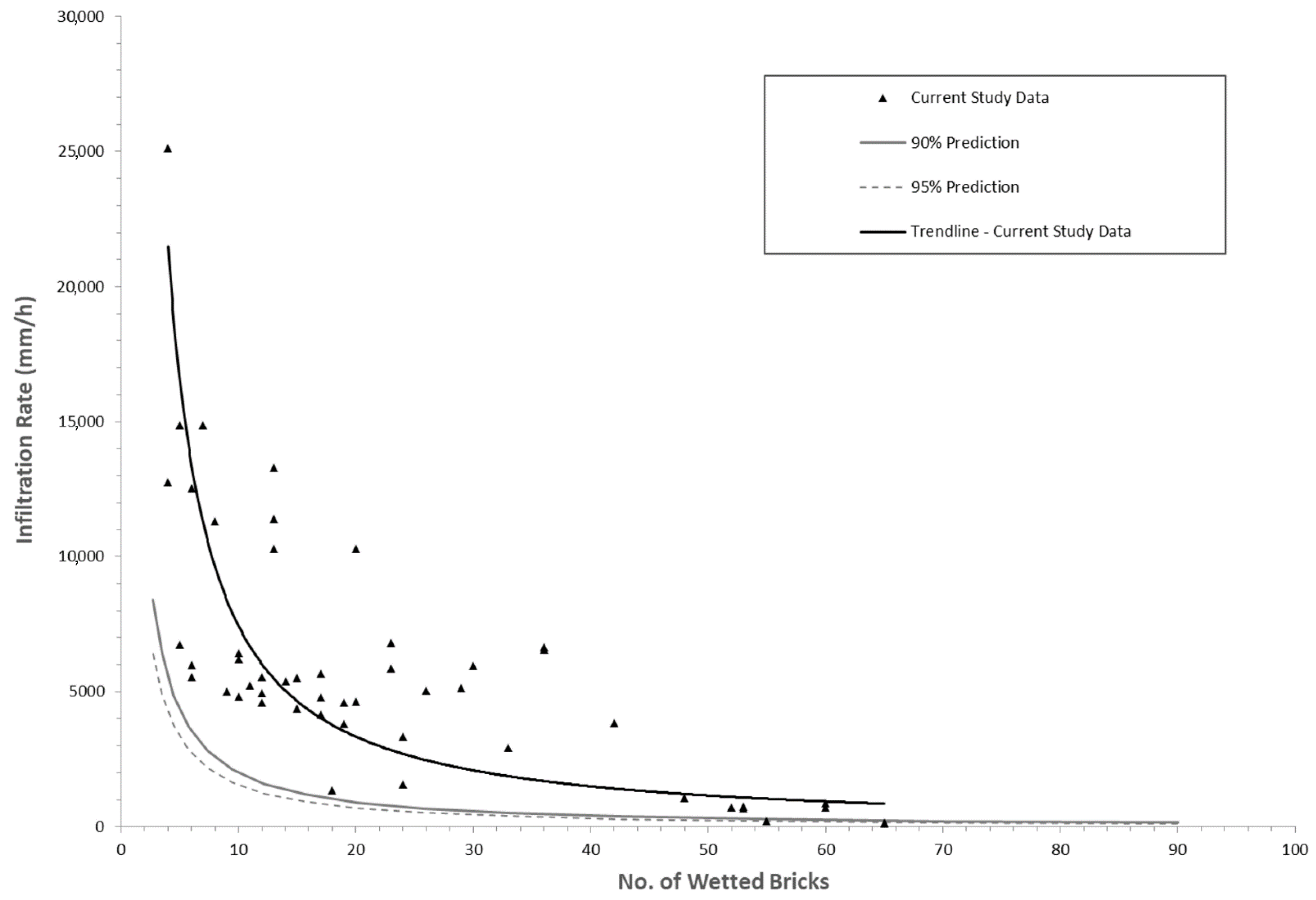
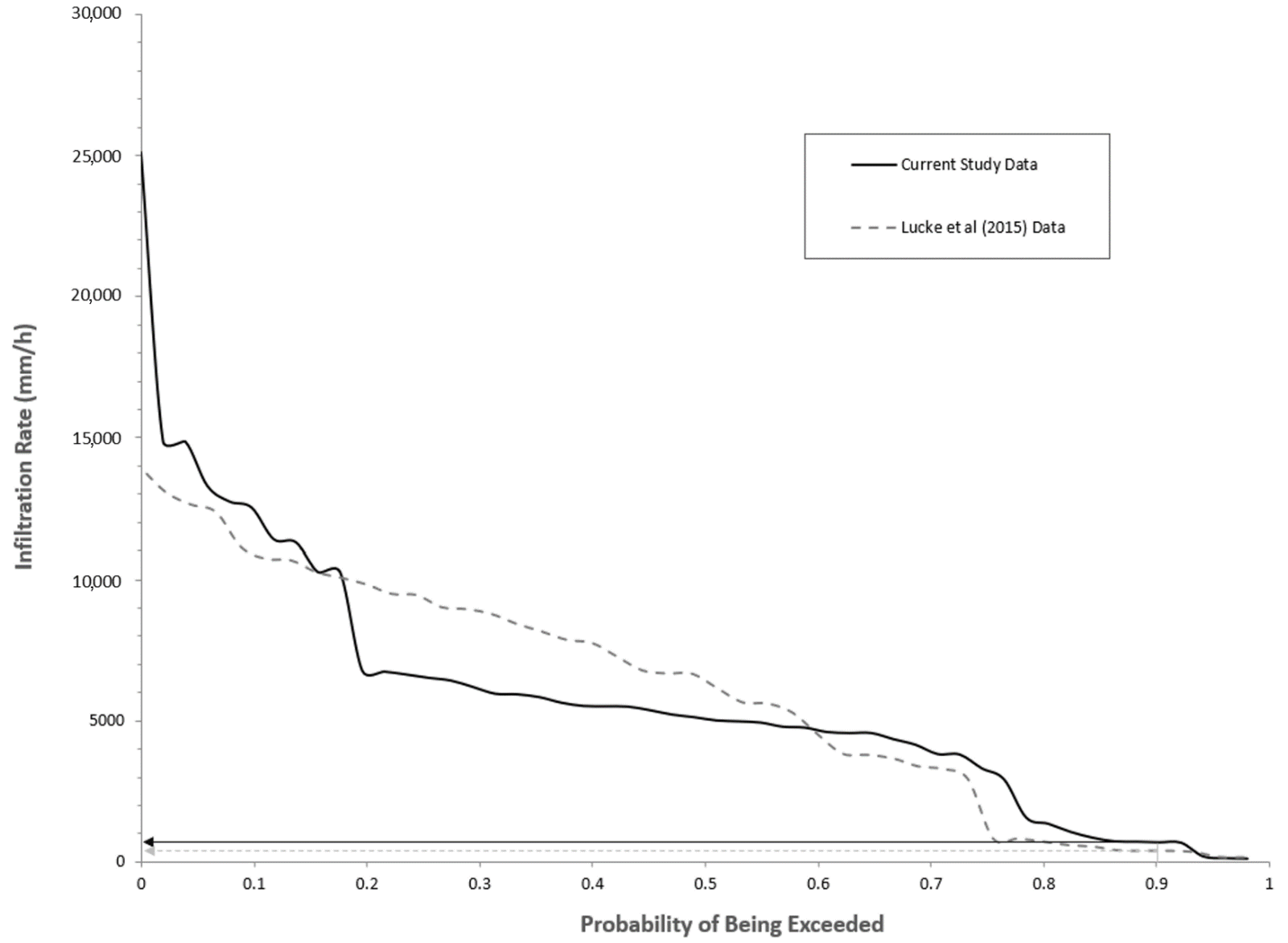
| Degree of Blockage | Free of Blockage | Medium Blockage | Complete Blockage |
|---|---|---|---|
| Infiltration Rate (mm/h) | >2000 | 30–2000 | <30 |
| Test No | Number of Wet Bricks | Usage | Infiltration Rate (mm/h) | Degree of Blockage * | Age in Years |
|---|---|---|---|---|---|
| R16 | 18 | Driveway | 1362 | Medium Blockage | 10 |
| R17 | 17 | Parking bay | 4772 | Free of blockage | 10 |
| R18 | 17 | Parking bay | 5654 | Free of blockage | 10 |
| R19 | 24 | Driveway | 3326 | Free of blockage | 10 |
| R20 | 60 | Driveway | 870 | Medium Blockage | 10 |
Publisher’s Note: MDPI stays neutral with regard to jurisdictional claims in published maps and institutional affiliations. |
© 2022 by the authors. Licensee MDPI, Basel, Switzerland. This article is an open access article distributed under the terms and conditions of the Creative Commons Attribution (CC BY) license (https://creativecommons.org/licenses/by/4.0/).
Share and Cite
Nguyen, N.P.T.; Sultana, A.; Areerachakul, N.; Kandasamy, J. Evaluating the Field Performance of Permeable Concrete Pavers. Water 2022, 14, 2143. https://doi.org/10.3390/w14142143
Nguyen NPT, Sultana A, Areerachakul N, Kandasamy J. Evaluating the Field Performance of Permeable Concrete Pavers. Water. 2022; 14(14):2143. https://doi.org/10.3390/w14142143
Chicago/Turabian StyleNguyen, Nam P. T., Albert Sultana, Nathaporn Areerachakul, and Jaya Kandasamy. 2022. "Evaluating the Field Performance of Permeable Concrete Pavers" Water 14, no. 14: 2143. https://doi.org/10.3390/w14142143
APA StyleNguyen, N. P. T., Sultana, A., Areerachakul, N., & Kandasamy, J. (2022). Evaluating the Field Performance of Permeable Concrete Pavers. Water, 14(14), 2143. https://doi.org/10.3390/w14142143






